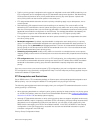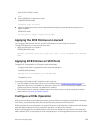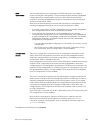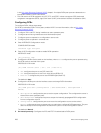Auto-
downstream
The port advertises its own configuration to DCBx peers but is not willing to
receive remote peer configuration. The port always accepts internally propagated
configurations from a configuration source. An auto-downstream port that
receives an internally propagated configuration overwrites its local configuration
with the new parameter values.
When an auto-downstream port receives and overwrites its configuration with
internally propagated information, one of the following actions is taken:
• If the peer configuration received is compatible with the internally propagated
port configuration, the link with the DCBx peer is enabled.
• If the received peer configuration is not compatible with the currently
configured port configuration, the link with the DCBx peer port is disabled and
a syslog message for an incompatible configuration is generated. The network
administrator must then reconfigure the peer device so that it advertises a
compatible DCB configuration.
– The internally propagated configuration is not stored in the switch's running
configuration.
– On a DCBx port in an auto-downstream role, all PFC, application priority,
ETS recommend, and ETS configuration TLVs are enabled.
Configuration
source
The port is configured to serve as a source of configuration information on the
switch. Peer DCB configurations received on the port are propagated to other
DCBx auto-configured ports. If the peer configuration is compatible with a port
configuration, DCBx is enabled on the port.
On a configuration-source port, the link with a DCBx peer is enabled when the port
receives a DCB configuration that can be internally propagated to other auto-
configured ports. The configuration received from a DCBx peer is not stored in the
switch’s running configuration. On a DCBx port that is the configuration source, all
PFC and application priority TLVs are enabled. ETS recommend TLVs are disabled
and ETS configuration TLVs are enabled.
Manual The port is configured to operate only with administrator-configured settings and
does not auto-configure with DCB settings received from a DCBx peer or from an
internally propagated configuration from the configuration source. If you enable
DCBx, ports in Manual mode advertise their configurations to peer devices but do
not accept or propagate internal or external configurations. Unlike other user-
configured ports, the configuration of DCBx ports in Manual mode is saved in the
running configuration.
On a DCBx port in a manual role, all PFC, application priority, ETS recommend, and
ETS configuration TLVs are enabled.
When making a configuration change to a DCBx port in a Manual role, Dell
Networking recommends shutting down the interface using the shutdown
command, change the configuration, then re-activate the interface using the no
shutdown command.
The default for the DCBx port role is manual.
Data Center Bridging (DCB)
261


















